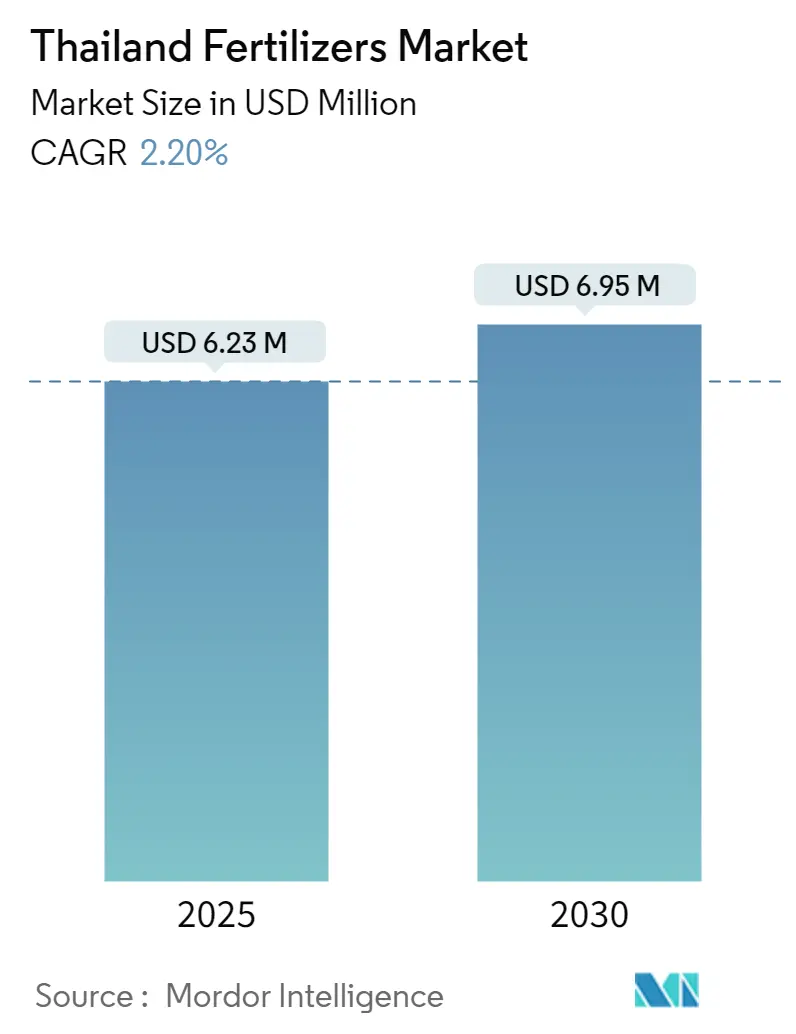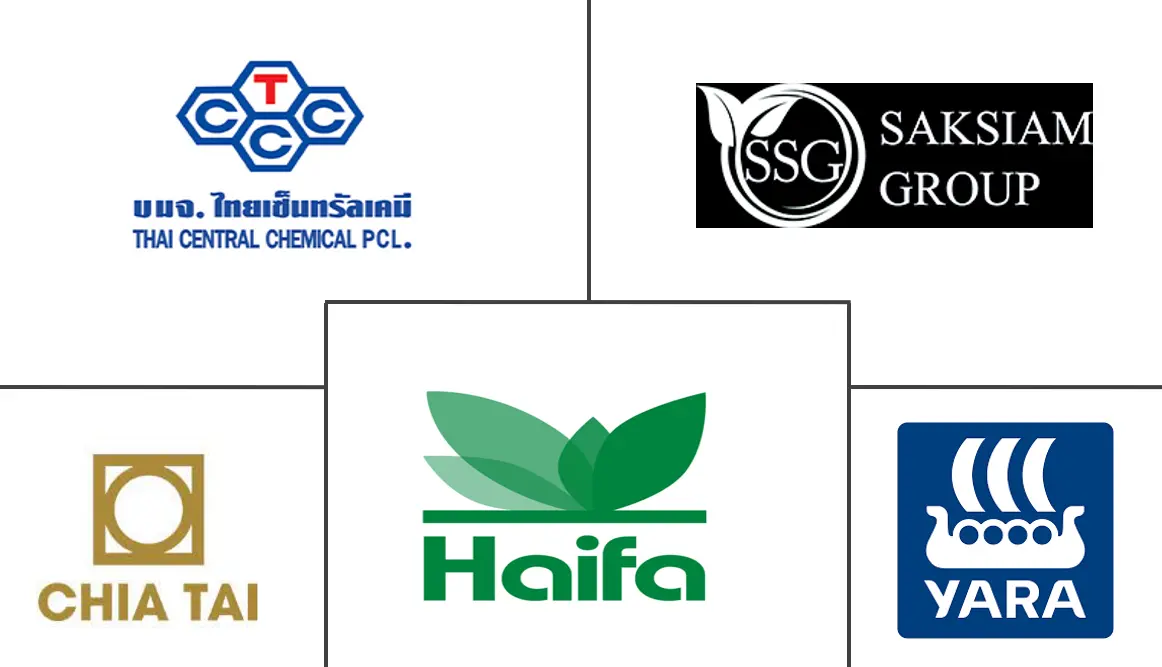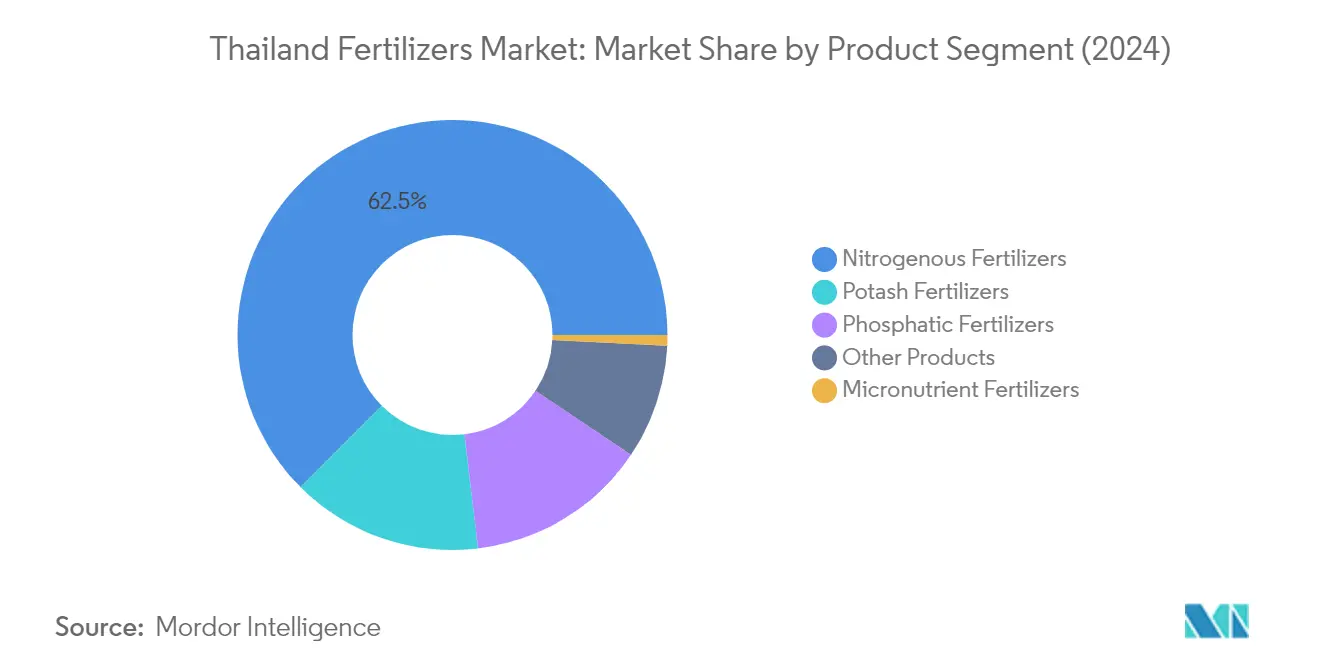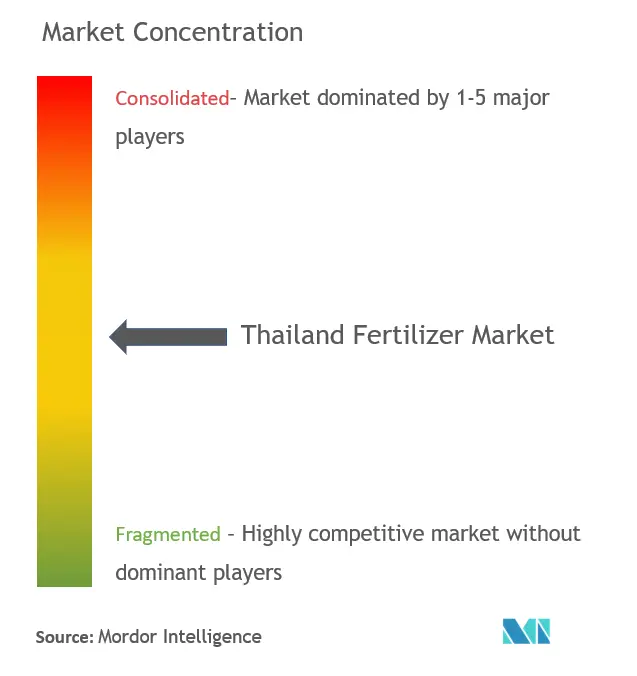
| Study Period | 2019 - 2030 |
| Base Year For Estimation | 2024 |
| Forecast Data Period | 2025 - 2030 |
| Market Size (2025) | USD 6.23 Million |
| Market Size (2030) | USD 6.95 Million |
| CAGR (2025 - 2030) | 2.20 % |
| Market Concentration | Medium |
Major Players
*Disclaimer: Major Players sorted in no particular order |
Thailand Fertilizers Market Analysis
The Thailand Fertilizers Market size is estimated at USD 6.23 million in 2025, and is expected to reach USD 6.95 million by 2030, at a CAGR of 2.2% during the forecast period (2025-2030).
The Thailand fertilizers market is experiencing significant transformation amid global supply chain disruptions and price volatility. According to the Thai Fertilizer and Agricultural Suppliers Association, chemical fertilizer prices in Thailand peaked at USD 1,200 per ton in 2023, including transportation costs, largely due to supply disruptions and higher transport costs. This price surge has prompted the country to explore domestic production capabilities, with the government announcing a USD 1.8 billion potash mining project in 2023 to reduce import dependency and stabilize domestic prices.
The market is witnessing a notable shift towards technological advancement and quality assurance in fertilizer production and distribution. In a significant development, SGS's fertilizer analysis laboratory became Thailand's first privately owned facility to be certified by the Thai Department of Agriculture for complete chemical fertilizer testing services. This certification reflects the industry's growing emphasis on quality control and standardization, particularly crucial given that approximately 98% of raw materials used in chemical fertilizers are imported into Thailand.
Thailand's agricultural export sector continues to drive demand for high-quality fertilizers, particularly in fruit production. The country's position as the seventh-largest fruit exporter globally, with exports reaching nearly USD 8 billion in 2022, has created sustained demand for specialized fertilizer products. This export-oriented agriculture has led to increased adoption of premium and specialty fertilizer products, especially in high-value crop segments such as durian, mangosteen, and longan production.
The industry is increasingly embracing digital transformation, aligned with Thailand's Board of Investment (BOI) initiatives to accelerate Industry 4.0 adoption. Many fertilizer companies are transitioning towards online channels and developing mobile applications to optimize fertilizer application and distribution. This digital shift is particularly evident in the development of precision agriculture solutions, with companies introducing innovative platforms for nutrient management and application optimization, contributing to more efficient fertilizer use and improved crop yields.
Thailand Fertilizers Market Trends
Rising Population and Limited Arable Land
The increasing population in Thailand has resulted in mounting pressure on agricultural productivity, particularly given the constraints of limited arable land. According to World Bank data, Thailand's arable land has remained constant at 16,810 thousand hectares during 2018-2020, while holding approximately 32.9% of the total land area. This scenario is further complicated by the average holding size of merely 3.15 hectares per farmer, which significantly restricts the optimization of crop output and necessitates the increased use of fertilizers to enhance productivity per unit of land.
The challenges are particularly pronounced in the Northeastern region, which hosts the largest number of farm holdings but faces multiple agricultural constraints. These include poor-quality soil, seasonality and variability of rainfall, scarcity of surface water, broken terrain, and steep slopes, all of which hinder crop production efficiency. These factors, combined with the unchanging arable land area and growing food demand, have made soil enrichment and fertilizer application crucial for achieving higher productivity gains and ensuring food security for the growing population.
Increasing Technical Innovations in the Fertilizer Industry
The fertilizer industry in Thailand is witnessing significant technological advancements aimed at improving agricultural productivity while promoting sustainable farming practices. A notable example is the 2021 innovation by the National Nanotechnology Center (NANOTEC) and the National Science and Technology Development Agency (NSTDA), which developed a revolutionary chelated fertilizer prepared from amino acids bonding with mineral micronutrients to form organic complexing agents. This breakthrough technology has demonstrated the potential to boost farm productivity by 20% while simultaneously reducing fertilizer usage by 50%, marking a significant advancement in fertilizer efficiency.
The industry's commitment to innovation extends beyond product development to include digital solutions and application technologies. Companies are increasingly investing in research and development to address specific agricultural challenges while improving nutrient utilization efficiency. For instance, Yara Thailand, in collaboration with DTAC, launched an app called "Kaset Go" to educate farmers about modern technologies for increasing crop yield. Additionally, the company has introduced new granular fertilizer products specifically designed for water systems, targeting greenhouse operations and farms using fertigation systems, demonstrating the industry's focus on developing specialized solutions for different agricultural needs.
Adequate Support from the Government
The Thai government has implemented comprehensive support mechanisms to boost agricultural productivity through various fertilizer-related initiatives and subsidies. In a significant development in 2023, the government announced the revival of a dormant potash mining project, demonstrating its commitment to establishing domestic fertilizer production capabilities. This USD 1.8 billion project aims to address fertilizer shortages and reduce prices at the domestic level, particularly important given the country's heavy dependence on imported potash.
The government's support extends beyond infrastructure development to direct farmer assistance through various subsidy programs and financial support mechanisms. A notable example is the allocation of THB 60.36 billion (USD 1.98 billion) for agricultural price subsidy programs targeting small rice and oil palm farmers. Furthermore, the government has strengthened its commitment to protecting farmers against natural disasters through the Rice Insurance Plan, with a substantial budget of THB 2.87 billion (USD 91.86 million). These support measures, combined with initiatives providing cheap agricultural nutrients and soft loans, create a favorable environment for increased fertilizer adoption and agricultural productivity enhancement.
Segment Analysis: By Product
Nitrogenous Fertilizers Segment in Thailand Fertilizers Market
Nitrogenous fertilizers continue to dominate the Thailand fertilizers market, commanding approximately 63% of the total market value in 2024. This significant market share is primarily attributed to the nitrogen-deficient soil conditions across Thailand due to the predominance of rice cultivation. Nitrogen fertilizer, particularly urea, remains the most frequently used nitrogenous fertilizer in the country, accounting for the largest share within this segment. The segment's dominance is further strengthened by the government's support through various subsidy programs and the increasing awareness among farmers about the importance of nitrogen in improving crop yields. The segment is also experiencing the highest growth rate in the market, driven by the rising population, limited arable land, and the need to enhance agricultural productivity. The increasing technical innovations in nitrogen-based fertilizers, including the development of enhanced efficiency products and improved application methods, are further contributing to the segment's growth and market leadership.

Micronutrient Fertilizers Segment in Thailand Fertilizers Market
The micronutrient fertilizers segment is emerging as a crucial component of the Thailand fertilizers market, demonstrating strong growth potential. The segment's growth is primarily driven by increasing awareness about micronutrient deficiencies in Thai soils, particularly in iron, copper, zinc, and boron. The primary soil-forming parent materials in Thailand are characteristically low in weatherable minerals, creating a natural demand for micronutrient supplementation. The northeastern region, with its weathered soil from coarse-grained sediments high in quartz, and the central highlands with limestone formations prone to iron deficiency, are key markets driving the demand for micronutrient fertilizers. Recent technological advancements, such as the development of chelated fertilizers with improved nutrient delivery systems, are further accelerating the segment's growth. The increasing focus on high-value crops and the growing understanding of the role of micronutrients in improving crop quality and yield are expected to maintain this growth momentum.
Remaining Segments in Thailand Fertilizers Market Product Segmentation
The phosphate fertilizer and potash fertilizer segments, along with other specialty products, form significant components of the Thailand fertilizers market. Phosphatic fertilizers play a crucial role in root development and early crop growth stages, with diammonium phosphate (DAP) being the preferred choice among farmers. The potash fertilizers segment is essential for improving overall crop quality and disease resistance, particularly in rice cultivation and commercial crops. The other products segment includes various specialty fertilizers and custom blends designed for specific crop requirements and soil conditions. These segments collectively contribute to a balanced nutrient management approach in Thai agriculture, with each serving specific agronomic needs and crop requirements. The market for these segments is supported by ongoing government initiatives to promote balanced fertilization practices and improve agricultural productivity.
Segment Analysis: Application
Grains and Cereals Segment in Thailand Fertilizers Market
The grains and cereals segment dominates the Thailand fertilizers market, accounting for approximately 53% of the total market value in 2024. This segment's prominence is primarily driven by rice cultivation, which accounts for a substantial portion of fertilizer consumption in the country. Nitrogen fertilizer is commonly applied in rice production to improve grain quality and productivity, as nitrogen is essential in promoting vegetative growth, grain yield, and quality. The segment's dominance is further strengthened by the application of fertilizers in other cereal crops like maize, which requires high amounts of nutrients, especially nitrogen (N), phosphorus (P), and potassium (K) due to its high dry matter yields. The segment is also experiencing the fastest growth rate in the market, projected to grow at around 7% during 2024-2029, driven by the rising food demand and increasing research activities aimed at improving crop yields through optimal fertilizer application.
Commercial Crops Segment in Thailand Fertilizers Market
The commercial crops segment represents the second-largest application area in the Thailand fertilizers market, with significant growth potential. The major commercial crops grown across Thailand include rubber, sugarcane, oil palm, and cassava, which require adequate amounts of essential plant nutrients for optimal growth and development. These high-value crops directly impact the economy of this region, leading to substantial capital investment in large-scale plantations to increase their yields. Micronutrient fertilizer plays a crucial role in supporting the growth of these crops during nutritional soil deficiency across the region. The segment's growth is further supported by Thailand's position as one of the world's leading sugar exporters, which has led to increased fertilizer application in sugarcane cultivation to boost yields.
Remaining Segments in Application
The remaining segments in the Thailand fertilizers market include pulses and oilseeds, fruits and vegetables, and other applications. The pulses and oilseeds segment is characterized by crops such as soybean, sesame, and mungbean, which require specific nutrient combinations for optimal growth. The fruits and vegetables segment is gaining importance due to Thailand's position as a major fruit exporter, with products such as durian, mangosteen, longan, and mango requiring specialized fertilizer applications. The other applications segment includes specialty crops like tobacco, cocoa, kenaf, and medicinal plants, each with unique nutrient requirements that contribute to the overall market dynamics. The use of granular fertilizer and compound fertilizer in these segments is essential for tailored nutrient delivery and efficient crop management.
Thailand Fertilizers Industry Overview
Top Companies in Thailand Fertilizers Market
The Thailand fertilizers market is characterized by a mix of domestic and international players demonstrating strong innovation capabilities and strategic growth initiatives. Companies are increasingly focusing on developing specialized and sustainable fertilizer solutions, with recent innovations including controlled-release technologies and micronutrient-enriched products. The market has witnessed significant product launches in water-soluble fertilizers and bio-based solutions, particularly targeting the growing demand for environmentally friendly alternatives. Operational agility is evident through companies' investments in digital platforms and mobile applications to enhance farmer engagement and provide technical support. Strategic expansions have primarily focused on strengthening distribution networks, establishing new warehouses, and forming partnerships with agricultural technology providers to improve product delivery and application efficiency. These developments reflect the industry's commitment to addressing evolving farmer needs while promoting sustainable agricultural practices.
Moderate Consolidation with Strong Local Presence
The Thailand fertilizers market exhibits a moderately consolidated structure, with major players accounting for less than half of the market share while numerous smaller players constitute the remainder. The competitive landscape is dominated by a combination of well-established domestic companies like Thai Central Chemical Public Company Limited and international giants such as Yara, creating a dynamic market environment. Local players leverage their deep understanding of regional agricultural practices and established distribution networks, while global companies bring advanced technologies and international expertise. The market has maintained a relatively stable competitive structure, with limited merger and acquisition activities observed in recent years.
The market is characterized by strong domestic manufacturing capabilities complemented by significant import dependencies for raw materials. Leading companies have established themselves through vertical integration, robust distribution networks, and strategic partnerships with agricultural input providers. The presence of state-owned enterprises and government involvement in agricultural fertilizer distribution adds another layer to the competitive dynamics, influencing pricing strategies and market access. Companies are increasingly focusing on developing specialized product portfolios catering to specific crop segments and regional requirements, rather than pursuing aggressive acquisition strategies.
Innovation and Sustainability Drive Future Success
Success in the Thailand fertilizers market increasingly depends on companies' ability to balance innovation with sustainability while maintaining competitive pricing. Market leaders are strengthening their positions through investments in research and development, focusing on enhanced efficiency fertilizers and environmentally friendly solutions. Companies are also expanding their digital capabilities, implementing precision agriculture technologies, and developing integrated crop nutrition solutions to differentiate their offerings. The growing emphasis on organic farming and sustainable agriculture presents both challenges and opportunities, requiring companies to adapt their product portfolios while maintaining profitability.
For new entrants and smaller players, success lies in identifying and serving niche market segments while building strong relationships with farming communities. The high concentration of end-users in specific agricultural regions necessitates robust distribution networks and technical support capabilities. Companies must navigate the increasing regulatory focus on environmental protection and sustainable farming practices, which may impact product formulations and application methods. The threat of substitution from organic fertilizer and biofertilizer alternatives requires companies to diversify their product offerings while educating farmers about the benefits of balanced nutrient management approaches. Future market success will largely depend on companies' ability to provide comprehensive solutions that address both productivity and sustainability concerns.
Thailand Fertilizers Market Leaders
-
Yara (Thailand) Company Limited
-
Thai Central Chemical Public Company Limited
-
SAKSIAM GROUP
-
Chai Tai Group
-
Haifa Group
- *Disclaimer: Major Players sorted in no particular order

Thailand Fertilizers Market News
- August 2024: Sojitz Corporation has established Sojitz Kaset Dee X Co., Ltd. (KDX) as an agricultural platform subsidiary in Thailand. Through KDX, Sojitz will enter the agricultural platform business, planning to initiate the supply and sale of farming services to cassava farmers in fall 2024. Sojitz aims to enhance farming efficiency and sustainability, ultimately increasing farmer prosperity through the development of KDX's farming services.
- June 2024: The Thai government is implementing a co-payment scheme to support fertilizer costs for more than 4 million rice-farming households. This initiative will be accessible to farmers through the Bank for Agriculture and Agricultural Cooperatives mobile app. To address concerns about price volatility, fertilizer suppliers will be invited to participate in standardizing prices.
Thailand Fertilizers Market Report - Table of Contents
1. INTRODUCTION
- 1.1 Study Assumptions and Market Definition
- 1.2 Scope of the Study
2. RESEARCH METHODOLOGY
3. EXECUTIVE SUMMARY
4. MARKET DYNAMICS
- 4.1 Market Overview
-
4.2 Market Drivers
- 4.2.1 Government Initiatives and Support
- 4.2.2 Declining Agricultural Productivity and Regional Challenges
- 4.2.3 Rising Food Demand
-
4.3 Market Restraints
- 4.3.1 Climate Change and Natural Disasters
- 4.3.2 Shift Towards Organic Farming
-
4.4 Porter's Five Forces Analysis
- 4.4.1 Bargaining Power of Buyers
- 4.4.2 Bargaining Power of Suppliers
- 4.4.3 Threat of New Entrants
- 4.4.4 Threat of Substitute Products
- 4.4.5 Intensity of Competitive Rivalry
5. MARKET SEGMENTATION
-
5.1 Product
- 5.1.1 Nitrogenous Fertilizers
- 5.1.1.1 Urea
- 5.1.1.2 Calcium Ammonium Nitrate (CAN)
- 5.1.1.3 Ammonium Nitrate
- 5.1.1.4 Ammonium Sulfate
- 5.1.1.5 Anhydrous Ammonia
- 5.1.1.6 Other Nitrogenous Fertilizers
- 5.1.2 Phosphatic Fertilizers
- 5.1.2.1 Mono-Ammonium Phosphate (MAP)
- 5.1.2.2 Di-Ammonium Phosphate (DAP)
- 5.1.2.3 Triple Superphosphate (TSP)
- 5.1.2.4 Other Phosphatic Fertilizers
- 5.1.3 Potash Fertilizers
- 5.1.4 Micronutrient Fertilizers
- 5.1.5 Other Products
-
5.2 Application
- 5.2.1 Grains and Cereals
- 5.2.2 Pulses and Oilseeds
- 5.2.3 Commerical Crops
- 5.2.4 Fruits and Vegetables
- 5.2.5 Other Applications
6. COMPETITIVE LANDSCAPE
- 6.1 Most Adopted Strategies
- 6.2 Market Share Analysis
-
6.3 Company Profiles
- 6.3.1 Yara International ASA
- 6.3.2 NFC Public Company Limited
- 6.3.3 Chai Thai Co. Ltd
- 6.3.4 Thai Central Chemical Public Company Limited
- 6.3.5 Haifa Group
- 6.3.6 SAKSIAM GROUP
- 6.3.7 ICL Group Ltd
- 6.3.8 Rayong Fertilizer Trading Company Limited (UBE Group)
- 6.3.9 Grupa Azoty S.A. (Compo Expert)
- 6.3.10 ICP FERTILIZER COMPANY
- *List Not Exhaustive
7. MARKET OPPORTUNITIES AND FUTURE TRENDS
**Subject to AvailabilityThailand Fertilizers Industry Segmentation
According to OECD, chemical fertilizers are commercially produced, usually synthetic, chemical compounds, such as nitrogen, phosphorus, and potassium, as well as a variety of micronutrients and additives used in farming. The Thailand fertilizers market is segmented by product (nitrogenous fertilizers, phosphatic fertilizers, potassic fertilizers, micronutrients fertilizers, and other products), and application (grains and cereals, pulses and oilseeds, commercial crops, fruits and vegetables, and other applications). The report offers the market size and forecasts in terms of volume in metric tons and value in USD for all the above segments.
| Product | Nitrogenous Fertilizers | Urea | |
| Calcium Ammonium Nitrate (CAN) | |||
| Ammonium Nitrate | |||
| Ammonium Sulfate | |||
| Anhydrous Ammonia | |||
| Other Nitrogenous Fertilizers | |||
| Phosphatic Fertilizers | Mono-Ammonium Phosphate (MAP) | ||
| Di-Ammonium Phosphate (DAP) | |||
| Triple Superphosphate (TSP) | |||
| Other Phosphatic Fertilizers | |||
| Potash Fertilizers | |||
| Micronutrient Fertilizers | |||
| Other Products | |||
| Application | Grains and Cereals | ||
| Pulses and Oilseeds | |||
| Commerical Crops | |||
| Fruits and Vegetables | |||
| Other Applications | |||
Thailand Fertilizers Market Research Faqs
How big is the Thailand Fertilizers Market?
The Thailand Fertilizers Market size is expected to reach USD 6.23 million in 2025 and grow at a CAGR of 2.20% to reach USD 6.95 million by 2030.
What is the current Thailand Fertilizers Market size?
In 2025, the Thailand Fertilizers Market size is expected to reach USD 6.23 million.
Who are the key players in Thailand Fertilizers Market?
Yara (Thailand) Company Limited, Thai Central Chemical Public Company Limited, SAKSIAM GROUP, Chai Tai Group and Haifa Group are the major companies operating in the Thailand Fertilizers Market.
What years does this Thailand Fertilizers Market cover, and what was the market size in 2024?
In 2024, the Thailand Fertilizers Market size was estimated at USD 6.09 million. The report covers the Thailand Fertilizers Market historical market size for years: 2019, 2020, 2021, 2022, 2023 and 2024. The report also forecasts the Thailand Fertilizers Market size for years: 2025, 2026, 2027, 2028, 2029 and 2030.
Our Best Selling Reports
Thailand Fertilizers Market Research
Mordor Intelligence provides a comprehensive analysis of the Thailand fertilizers market. We leverage extensive expertise in agricultural inputs and plant nutrients research. Our detailed study covers the complete spectrum of fertilizers, including segments such as NPK fertilizer, organic fertilizer, and biofertilizer. The analysis includes crucial categories like nitrogen fertilizer, potash fertilizer, phosphate fertilizer, and emerging specialty fertilizer solutions. These insights are essential for stakeholders interested in soil amendment practices and optimizing agricultural nutrients.
The report, available as an easy-to-download PDF, offers an in-depth examination of liquid fertilizer, granular fertilizer, and solid fertilizer markets. It also analyzes developments in chemical fertilizer and synthetic fertilizer. Stakeholders gain valuable insights into micronutrient fertilizer trends, compound fertilizer innovations, and soil enrichment strategies. The study particularly focuses on inorganic fertilizer applications and agricultural fertilizer demand patterns. This provides essential data for industry participants seeking to understand crop nutrients dynamics in Thailand's evolving agricultural sector.




